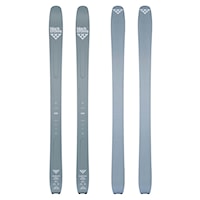How to Choose Touring Skis
4th January 2023 | 0 comments
Are you interested in ski touring? If you want to get started in this amazing sport, it's a good idea to know what to choose as your basic equipment - Touring Skis. We'll help you choose the best ones!

To make sure your skis serve you well, you need to be clear about how you will use them. Do you mainly want to climb and you're a flyweight, or are you more of an avid freerider who just needs to get up there somehow? Do you ride aggressively in the roughest terrain, or do you prefer to cruise? You need to think about all this beforehand. Let's break it down and illustrate with the Black Crows Freebird series.
Ski Touring Terminology
Speed Touring
If you're a hardcore sportsman who runs, rides a bike, is a racer at heart and loves ascents, this will be your idea of ski touring. Speedtouring uses the lightest, narrowest and often shortest skis that will have you up there in no time. Thanks to the latest technology and modern construction, even downhill is no longer a terror, but in powder, for example, it'll take a bit of self determination and some serious skill. Speedtouring is performance training that will make you sweat.
Ski Width: up to 85 mm
Ski Length: shorter than body height (150-170 cm)
"Classic" Ski Touring
A skier who likes to both climb and ski down on fresh powder chooses versatile and balanced skis, usually between 85 and 95 mm wide under bindings. They can handle the climb without unnecessary extra weight, but they also have excellent downhill potential and enough lift to float through powder. With this gear, you'll be at ease exploring untouched mountain scenery and enjoying the tour from start to finish.
Ski Width: 85–95 mm
Ski Lenght: 5-10 cm shorter, possibly matching the height of the body
Free Touring
For those who prefer the ultimate downhill experience, the last category is Freetouring. Climb the hill and have an uncompromising freeride! Wide skis, often over 100 mm, are included here, and longer skis are usually chosen, so you'll float through powder like a steamboat on the water. In exchange for that extra gram, you get epic downhill and rideability approaching that of an all-mountain ski.
Ski Width: from 95 mm
Ski Length: the same or up to 8 cm longer than body height

Black Crows Corvus Freebird
989.90 €

Black Crows Ferox Freebird
1 071.90 €

Armada Locator 104
828.90 €
Ski Touring Binding
For light skis, a light touring binding, but for free touring you need a more robust, safe binding with brakes. That's a very simplistic rule of thumb, because in reality, choosing a touring binding is quite a complicated matter.
Let's start with speed touring, a discipline where weight matters a lot. If you're in this group, you'll definitely want to go for lightweight pin/tech binding. The most extreme racing pieces weigh only a few dozen grams, but if you're expecting safety features or brakes - and we recommend this for all but hardcore shooters - you need to reach for a slightly heavier and more sophisticated model.
The hybrid binding offers a great combination of performance, safety and weight. It uses pins in climbing mode, but functions like a classic all-mountain binding in downhill mode, including safety features. It's a great choice for the skier who wants to climb and ski to their heart's content.
The last option ideal for free touring is a frame binding. If we simplify it a bit, it's actually a full alpine binding mounted on a ski that has an unlocking heel. It's compatible with downhill boots, making it suitable for freeriders and downhill skiers who only go out on the trail occasionally.

Armada N Tracer Tour
499.95 €

G3 Zed 12
518.90 €

Fritschi Xenic 10
473.90 €

Fritschi Vipec Evo 12
577.90 €

Armada N Shift MNC 13
529.95 €

Tyrolia Ambition 10 MN W/O Brake C
255.90 €
Ski Touring Boots
Choosing ski touring boots is also quite an alchemy. Just like other equipment, it must match your ascent-to-descent ratio requirements. Choosing boots to match your bindings and skis is an absolute must, otherwise you're in danger of not only ruining your ski touring experience, but you might even run into compatibility issues.
Boots for speed touring and ski touring need to give you enough comfort for the climb, yet be as light as possible and stiff enough for a sure descent. Compared to downhill boots, they have a lighter construction and often fewer buckles, which in some models are completely replaced by BOA or other tightening systems. If you want to chase grams a lot, you can also reach for ultralight skis that use carbon in their construction and have a more open construction.
In any case, easy switching between walking and downhill mode is also important, and the base must have a grippy rubber surface - the legendary Vibram is often used. Of course, if you don't have frame binding, there must be no shortage of tech inserts in the toe box. When choosing, be sure to also pay attention to sufficient range of motion of the upper part of the boots (optimally at least 60°) and the right flex index for your weight and riding style.
If you're into free touring, then look for more robust freeride boots that are more similar to downhill boots. These need a stiffer flex and, conversely, a smaller range of motion.
Of course, the main thing is always to test the boots thoroughly, check their compatibility with the bindings and, if they allow it, have them thermoformed to fit you perfectly.
Other Equipment for Ski Touring
You'll need ski touring skins, poles, crampons and, of course, highly technical clothing before you start touring.
Check out all the ski touring equipment.










